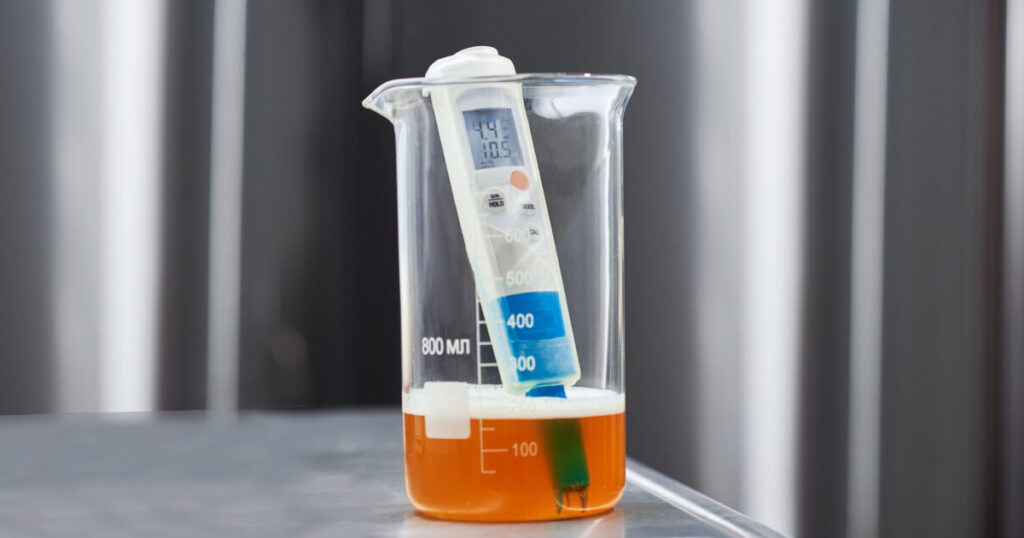Acid in Beer: The Science and Scientists
How the brewing industry changed chemistry, and the scientists responsible for the revolution.

In 1909, the head scientist of Carlsberg Research Laboratory, S.P.L. Sørensen introduced the pH scale as an easy way to conceptualize acidity of aqueous solutions. His research, funded privately by Carlsberg Brewery, was part of the efforts to understand the biochemical processes of brewing and fermentation. However, in the following two decades the logarithmic scale of acidity proved its importance in nearly every aspect of chemistry, biology, and agriculture.
What Is an Acid?
There are three primary definitions of “acid” in chemistry, depending on the scope and framework of the question. For the remainder of this article, we will be sticking to the oldest and simplest definition, known as the Arrhenius acid: an acid is a substance that increases the hydrogen ion concentration of an aqueous solution when added to that solution. Acidity, therefore, is a measurement of how many free hydrogen ions a solution has available to react with oppositely charged ions. These hydrogen ions are single protons with no associated electron so they have a slightly positive charge.
Why Does Acidity Matter?
Those protons really don’t want to be alone! While they might have fun floating around in water, they will form ionic bonds with any available negative ions they come across, which can have detrimental effects on all kinds of compounds. Acids can insinuate themselves into complex protein structures, denaturing them and removing their functionality. Some metals will form salts with acids, releasing hydrogen gas and dissolving into powder. It’s not hard to see why measuring the acidity of a solution, and therefore the number of available protons could be important for biochemists.
Brewing Chemistry
Carlsberg Research Laboratory was established in order to introduce scientific methods to the artisanal practice of brewing. Its founder, J.C. Jacobson, wanted to industrialize beer-making and reasoned that having a deeper understanding of the science behind the processes would ease this transition. From this lab came the first pure isolated brewer’s yeast, as well as the pH scale which we use to this day. S.P.L. Sørensen was researching the effect of ions on yeast proteins and those excitable little hydrogen ions were having a surprisingly large impact. He developed the pH scale to measure the quantity of hydrogen ions in water, reduced to a number that humans can grasp. By using the negative decimal logarithm, he made a directly proportional scale where adding millions of hydrogen ions would only decrease the pH by a few points on the scale.
Why Do We Measure Acidity in Beer?
As mentioned, a brewer should keep acidity in mind for every aspect of brewing from selecting the correct metals for brewing equipment to dialing in the flavor of a seasonal fruit beer. One of the first steps of the brewing process, mashing grain, relies on the activity of the enzymes alpha and beta-amylase. These two catalysts work in tandem to convert long-chain carbohydrates into fermentable sugars, but they operate best at different pH levels. Alpha-amylase performs well in neutral solutions (around pH 7) while Beta-amylase is suited for slightly acidic environments (around pH 5). Typically the pH of the mash will remain around pH 5.4 which is a reasonable compromise between the two amylases. However several factors can drive the pH higher or lower which would inhibit some enzyme activity, so it is important to monitor the acidity and make adjustments as necessary.
Yeast and Acid Production
Observing the rate at which pH decreases during fermentation allows brewers to monitor the health of their yeast. After pitching, yeast acidify their environment quickly through the production of organic acids to make the wort more hostile to competitive microorganisms. Issues with yeast metabolism or infection of the product can drop the pH lower than yeast can withstand, which may lead to stalled fermentations. Yeast use an ion gradient (including free hydrogen ions) across their cell membrane to facilitate transport of nutrients in and out of the cell, therefore an unexpected drop in pH can reduce their ability to metabolize sugars.
See pH in Action
Ever wondered what pH monitoring on a micro level can look like? The data can be a powerful tool in brewing, especially when combined with other metrics like gravity and dissolved oxygen. Discover the impact of the BrewMonitor, which gives never before seen data insight. Just as Sørensen changed the game, we too are evolving fermentation so you can have more control over your process, product, and profit. See the insights in a live demo.

